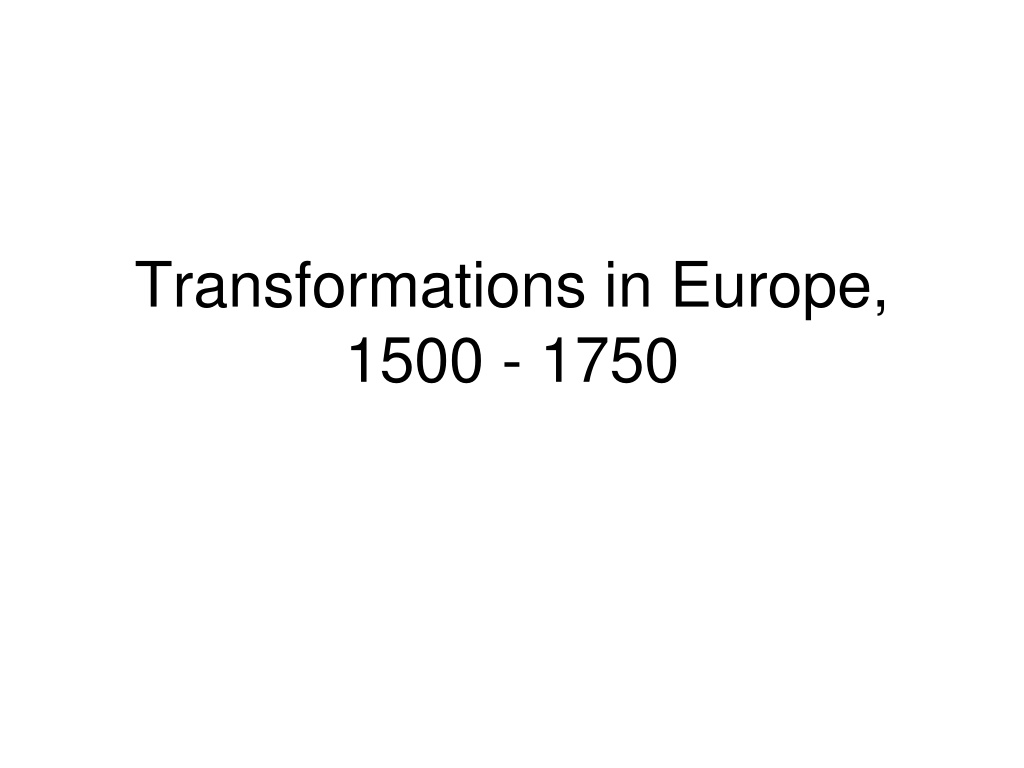Transformative Period in Europe (1500-1750): Culture, Ideas, Religion, and Science
Explore the significant transformations in Europe from 1500 to 1750, including cultural shifts, religious reformations led by figures like Martin Luther and John Calvin, witch hunts, and the Scientific Revolution challenging traditional beliefs. Witness the impact of the Enlightenment era as it reshaped laws and behaviors, paving the way for intellectual progress.
Download Presentation

Please find below an Image/Link to download the presentation.
The content on the website is provided AS IS for your information and personal use only. It may not be sold, licensed, or shared on other websites without obtaining consent from the author. Download presentation by click this link. If you encounter any issues during the download, it is possible that the publisher has removed the file from their server.
E N D
Presentation Transcript
Transformations in Europe, 1500 - 1750
A. Religious Reformation Papacy St. Peter s Basilica Indulgences Martin Luther (1483 1546) Salvation from faith in Jesus Christ not works Rejection of papal authority Protestant Reformation Bible, printing press German support/nationalism Photo: Luther nails his 95 theses to the door of Wittenburg Cathedral in the film, "Luther."
Religious Reformation Continued John Calvin (1509 1564) Faith not enough, salvation a gift from God predestined Organization, lifestyle Religious movements connected to political circumstances Trent Catholic Reformation Jesuits Wars of Religion
B. Traditional Thinking and Witch - Hunts Folklore/magic Christian teachings miracles, devils, etc. Natural events supernatural causes Lisbon 1755 Accused women and their fates Reformation s focus on the Devil Fear of independent women Women s sphere of influence
C. The Scientific Revolution Influence of Greco Roman sources/Bible Aristotle four elements and physics Pythagoras Scientific Revolution observation Nicholas Copernicus (1473 1543) heliocentric universe Tycho Braches and Johannes Kepler elliptical orbits
The Scientific Revolution Continued Galileo Galilei (1564 1642) telescope Challenge to religious/traditional beliefs Galileo s view of God s truth Jesuits, Roman Inquisition, The Starry Messenger Robert Boyle chemistry Isaac Newton (1642 1727) common physics, law of gravity Hostility of the church, challenges to authority
D. The Early Enlightenment Laws of human behavior Enlightenment Resistance to Enlightenment thinkers Reaction against religious violence Appreciation of non Western examples of governance/behavior Optimistic about future of human behavior/institutions
A. The Bourgeoisie Population growth in London, Paris Bourgeoisie work/lifestyle Netherlands textile industry, used foreign raw materials, publishing endeavors Amsterdam commercial fleets dominated overseas trade during 1600s Merchant ships fluit, East Indiaman Dutch banks investments, capital Cartography
The Bourgeoisie continued Family connections/merchant colonies in European cities Alliances with monarchies Joint stock companies Stock exchanges Canals British/Dutch competition English supremacy Gentry alliances with old nobility; exemption from taxes
B. Peasants and Laborers Decline of serfdom/slavery in Western Europe relation to the Americas Challenges to peasants Little Ice Age Impact of new crops from Americas by 1700 Exports of wheat Deforestation (1709), impact on peasants Migration to cities - no relief from poverty Rebellions of the poor in Early Modern Europe resentment against privileged/landowning classes, exemption from taxation
C. Women and the Family Women lower than men but mitigated by class/wealth Importance of a good marriage Choice in marriage/reasons for age Abandoned children Solid education for sons languages, business Exclusion/participation of women in Renaissance, Scientific Rev., Enlightenment
A. State Development Political diversity Holy Roman Empire German Charles V Habsburg united Christian Europe vs. Ottomans French/German opposition German Wars of Religion and the Peace of Augsburg (1555) France, Spain, England strengthening central authority
B. Religious Policies Spain/France defended Catholicism (Spanish Inquisition) French Wars of Religion Henry of Navarre, Edict of Nantes England Henry VIII, Catherine of Aragon, support of Parliament to make English monarch head of Church of England Disbanding of monasteries/church lands Not as many reforms as English Puritans wanted
C. Monarchies in England and France England Charles I disbanded Parliament, needed help to gather taxes, Parliament wanted guarantees of rights English Civil War in 1642 Charles I executed, Oliver Cromwell instated, eventually Charles II restored James II a Catholic threat Queen Mary and William of Orange Glorious Revolution of 1688 English Bill of Rights 1689
Monarchies in England and France Continued Estates General Monarchs sold appointments/efficient tax collection Louis XIV Palace of Versailles, kept political intrigues out of Paris French model widely admired John Locke (1632 1704) disputed divine right of monarchs, authority from consent of the governed
D. Warfare and Diplomacy Warfare common in Early Modern period Expensive/destructive Thirty Years War (1618 1648) European armed forces much stronger larger armies, centralized command structures, training, fortifications Stalemates navy Henry VIII investment in navy, influence of the Dutch, creation of Great Britain Prevented Spain/France from uniting Balance of power
E. Paying the Piper Post 1600 states needed more revenue for militaries Alliances with rising commercial elite needed space AND support Spanish wars, religious expulsions, and aristocratic exemption from taxes American gold/silver inflation Netherlands revolted against Spanish policies 1648 achieved full independence
Paying the Piper Continued United Netherlands decentralized excelled in trade, commercial interests Rise of the English navy/merchant ships English financial revolution taxed aristocracy, collected taxes directly, central bank France some adjustments but stifled by aristocracy























